Veteran’s Testimony – Margaret M. Eggert 250th Station Hospital

Portrait of First Lieutenant Margaret M. Eggert, ANC, N-731929, 250th Station Hospital.
Introduction:
Margaret Marie Eggert was born in Detroit, Michigan, 16 August 1915. She is the daughter of Anthony Bernard Eggert and Mary Alecia Colton, also born in Detroit, Michigan (children of German immigrants). Margaret had only one younger sister, Dorothy M. Eggert, born in 1920 (died in 1983).
Margaret M. Eggert, first went to St. Anthony’s Grammar School (Roman Catholic school), in Detroit, where she graduated in 1929. She finished High School after four years, graduating from St. Mary’s Academy (Roman Catholic Sisters of the Immaculate Heart of Mary), in Monroe, in 1933. She later attended Marygrove College (University of Michigan extension) for one year and then joined St. Joseph Mercy Hospital – Mercy College of Nursing, in Detroit, Michigan, for more training, finally graduating as a Registered Nurse in 1937. Nurse Eggert did one year post-graduate in OB at Sloane Hospital for Women (specialized in Obstetrics and Gynecology), New York, N.Y.
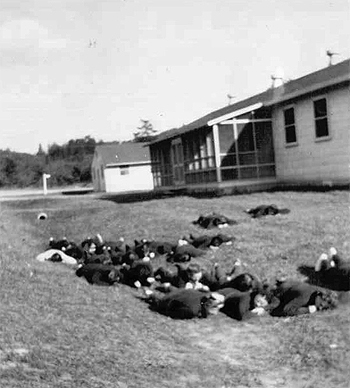
Camp McCoy, Sparta, Wisconsin, spring 1943. Group of Nurses practicing for the Infiltration Course (part of Basic Training).
Being a Registered Nurse (in the State of Michigan 1937), Margaret did not need to register for Selective Service. She did however apply for duty with the Army Nurse Corps, filling out the necessary forms as early as 15 October 1942 (she was then 27 years old –ed) eventually being assigned to active service as a Reserve Nurse, Army Nurse Corps, Army of the United States with the ‘relative’ rank of Second Lieutenant and receiving ANC Serial Number N-731929. Lieutenant Eggert, took the prescribed oath on 4 January 1943 and became a Nurse, General Duty (MOS 3449). Nurse Eggert would serve her country from 4 January 1943 to 28 February 1946. Margaret M. Eggert married William T. O’Neill on 27 April 1946, in Detroit, Michigan. Two children were born, Stephen T. O’Neill and Mary K. O’Neill.
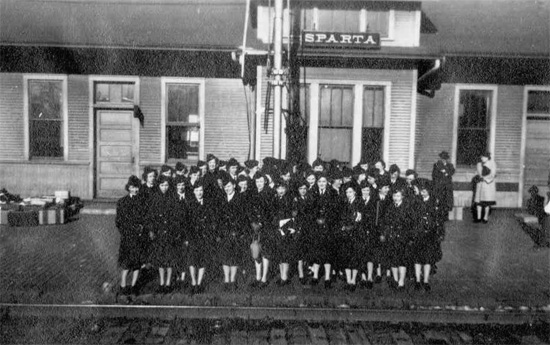
Nurses contingent at Sparta’s railway station, ready for departure 12 December 1943. After completing Basic Training, Second Lieutenant M. Eggert received orders assigning her to the 250th Station Hospital, at Camp Phillips, Salina, Kansas.
After entering active duty with the ANC, Second Lieutenant M. Eggert wanted to join the Wayne University medical staff. Unfortunately, she did not pass her physical, failing the eye test. As a result of this, she would never deploy with the affiliated 36th General Hospital (activated 28 May 1943, embarked for North Africa 10 August 1943 –ed). Notwithstanding this unfortunate situation, Second Lieutenant Margaret M. Eggert received orders to report to the station hospital at Camp McCoy, Wisconsin, as from 5 January 1943. She was to remain at Camp McCoy (working in the OB department) for almost one year, leaving the post for a change of station and a new unit 11 December 1943.
Training & First Assignment:
As per Paragraph 28, Special Order No. 296, Headquarters, Sixth Service Command, Chicago, Illinois, dated 7 December 1942, signed by Captain Nellie E. McGovern, ANC, Chief Nurse; Second Lieutenant Margaret M. Eggert, ANC, N-731929, joined the Post’s station hospital at Camp McCoy, Sparta, Wisconsin (Division camp; total acreage 60,284; troop capacity 2,485 Officers and 39,921 Enlisted Men –ed), where she reported for duty 5 January 1943 and was ordered to complete the Basic Training Program for Nurses (she had already received a lot of training at Wayne MI unit).
Military processing began at once the following day, with War Department AGO Form No. 41 and Federal Bureau of Investigation fingerprints forms mailed to the Adjutant General’s Office. The series of required inoculations/vaccinations followed on 6 June 1943, against smallpox (received 6 Jan 43), eventually followed by typhoid vaccine (received 20 Jan 43), and tetanus toxoid (received 17 Feb 43).
On 27 February 1943, Lieutenant Eggert received the official War Department AGO Form No. 65-1, Officers’ Identification Card No. 523912, issued by the Medical Department, US Army.

Swindon, England, mid-April 1944. The 250th Station Hospital Nurses temporarily joined the “Nurses Provisional Battalion” at Swindon awaiting a change of Station. From L to R: Second Lieutenants Frances E. Dunning; Jean H. Duffy; Marie L. Lowe; Ann Heiser; Marion E. Castrodale; Faith A. Oldham; Gwyneth Edge; Doris M. Allshouse; Beatrice O. Patterson.
Clothing issued 27 February 1943
1 Cap, Garrison
3 Caps, White
1 Coat, Covert, Blue
1 Pair of Gloves, Suede, Grey
2 Pair of Shoes, White
2 Pair of Shoes, Black
6 Uniforms, White
1 Cape, Dark Blue
2 Waists, Cotton, White, Women’s
2 Waists, Cotton, Blue
1 Sweater, Dark Blue
1 Pair of Overshoes, Arctic, 4-Buckle, Women’s
4 Pairs of Insignia (US + ANC Branch)
Having applied for overseas duty, Margaret was waiting for a possible re-assignment to a Hospital unit bound for transfer to an overseas Theater. She obtained her last 7 days of leave of absence with pay from 11 to 17 October 1943, still expecting to be called up for a new assignment. Nurse Eggert was unable to deploy because during tests it was found that she didn’t have 20/20 vision. The military authorities later allowed people with corrected 20/20 vision (glasses) to deploy.
Finally, Special Orders dated 10 December 1943, issued by Headquarters, Camp McCoy, Sparta, Wisconsin, instructed Second Lieutenant Margaret M. Eggert to leave her current assignment with the Post Hospital and to proceed to the 250th Station Hospital, Camp Phillips, Salina, Kansas, Zone of Interior for re-assignment to this organization.
Final Assignment:
Lieutenant M. Eggert took the train 12 December 1943, on her way to her new assignment in Kansas. Upon arrival and after due registration, she was officially assigned to the 250th Station Hospital, activated at Camp Phillips, Salina, Kansas, 25 February 1943, and currently under command of Colonel Arthur E. White, MC, O-19328.
In the unit’s personnel roster dated 31 December 1943, Second Lieutenant Margaret M. Eggert’s duty is described as “Ward Nurse – Contagious Ward”. At the time, the Principal Chief Nurse was First Lieutenant Katharine L. Knott, ANC, N-772339 and the Chief Nurse – Contagious Ward was Second Lieutenant Pauline Z. Hinkley, ANC, N-772554.
She arrived just in time before the unit was to entrain for its Staging Area at Camp Kilmer, Stelton, New Jersey, which was scheduled for 15 December. Margaret Eggert was part of a group of Nurses destined to bring the organization to its authorized strength, a full complement of 75 ANC Officers, prior to overseas movement.
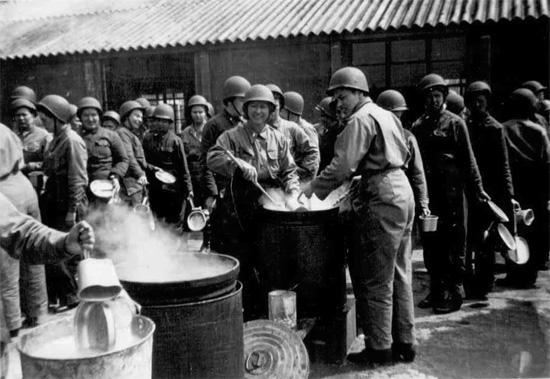
Burford, England, May 1944. 250th Station Hospital Nurses washing up mess kits after having chow. At the time the Nurses were on temporary service with the 203d General Hospital, for quarters, rations, and training.
Preparation for Overseas Movement:
After receiving their last shots and instructions for deployment overseas, the Nurses were granted a 12-hour leave to New York City. On 29 December 1943, the unit finally departed New York P/E on the British Transport “Samaria”, with destination the European Theater of Operations.
Besides the Nurses, the other female personnel consisted of 2 Physio-Therapy Aides, 1 Hospital Dietitian, and 3 Red Cross workers, all assigned to the 250th Station Hospital.
Equipment Issued 22 December 1943 (prior to shipment)
1 Helmet, Steel, M-1, Complete
1 Bag, Canvas, Field, Olive Drab, M-1936
1 Belt, Pistol or Revolver, M-1936
1 Can, Meat, M-1932 or M-1942
1 Canteen, M-1910 or M-1942
1 Cover, Canteen, Dismounted, M-1910
1 Cup, Canteen, M-1910 or M-1942
1 Fork, M-1926
1 Knife, M-1926
1 Spoon, M-1926
1 Pouch, First-Aid Packet, M-1942
1 Roll, Bedding, Waterproofed, M-1935
1 Strap, Carrying, General Purpose
1 Suspenders, Belt, M-1936
1 Necklace, Identification Tag with Extension
1 Pair of Shoes, Field, Women’s
2 Blankets, Wool, Olive Drab, M-1934
Additional Items Issued 22 December 1943
Complete Set of Field Clothing & Equipment
Complete Herringbone Twill Impregnated Clothing
Geneva Convention Red Cross Armband

Group of 250th Station Hospital Nurses, at the end of their stay at Burford, England, 27 May 1944. From L to R back row: Second Lieutenants Elizabeth S. Kennedy; Irene A. Losin; Camillus R. Justus; Eleanor A. Obernuefeman; Kathleen L. Robedeaux; Eva Ann S. Bockelman; Beatrice O. Patterson; Josephine O’Meara; American Red Cross aide; Dorothy A. Deposki; Evangeline V. Bakke; Helen M. Zalewski, front row: Florence Funtowitz; Phyllis J. Perkins; Rita A. Davison; American Red Cross aide; Helen M. Flanagan; Marion E. Castrodale; Carolyn J. Rhora; Alice M. Spencer; Ida H. Kim.
United Kingdom:
After crossing the Atlantic without any mishaps, HMT “Samaria” docked at Liverpool, England, on 8 January 1944. The evening of the following day, all the personnel debarked and entrained in different groups, bound for Cheltenham, Gloucestershire, United Kingdom. It was night, cold, and the groups marched in formation under a pouring rain to the train station. It must be said, that everyone received hot coffee, donuts, and gum, from the always-present ARC girls. The journey went on in complete black-out conditions, a situation nobody in the 250th had ever witnessed before. From Cheltenham the group continued further by motor convoy to Ullenwood, only a few miles from Cheltenham, Gloucestershire, where the personnel arrived in the early morning of 10 January 1944. Instructions were to take over the existing hospital site (including over 200 patients) from the 32d General Hospital which effectively took place on 18 January 1944.
Before settling down, any available money had to be converted to the complex British Pound Sterling currency (£ 1.00 was worth approximately US$ 4.00). After being assembled, groups of personnel were assigned quarters. Nurse Eggert remembers that she moved into a seven-person hut construction. It was quite difficult to adapt to the local climate, the weather was not only damp and cold, but the quarters were inadequately heated for the season.
Between January and February 1944, the Nurses began to grow more accustomed to the United Kingdom, the people, the customs, the language, the currency, and local circumstances. There was a war situation to keep in mind. Because of the weather, it was almost impossible to arrange for country trips (they would take place later), nevertheless, the leaves and passes to places like London, England and Edinburgh, Scotland were quite popular. The personnel received the necessary instructions and air-raid exercises were conducted in order to know what to do in case of enemy bombing.
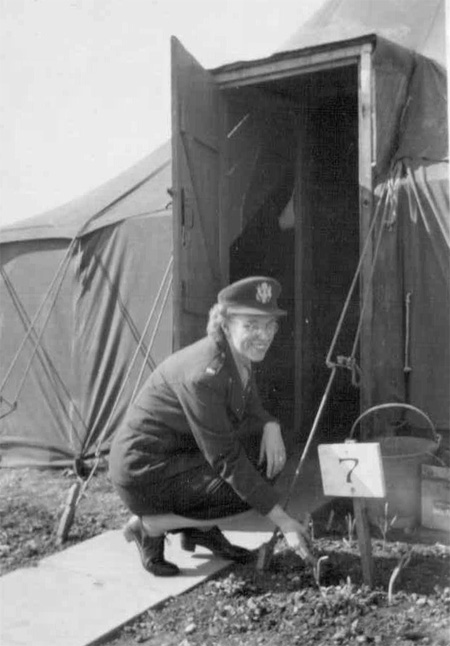
Grimsditch, England, mid-June 1944. Tent No. 7, Nurse Margaret Eggert with first daffodils.
On 14 April 1944, Nurse Eggert reported to the “Nurses Provisional Battalion”, at Swindon, Wiltshire, as per Letter, Movement Order No. 86, Headquarters, Services of Supply, ETOUSA, dated 12 April 1944. The reason for sending over all the Nurses on DS to Swindon, was that the 250th was being relieved by the 62d General Hospital, and therefore had to change stations (Officers and Enlisted Men were transferred to Pinkney Park, Wiltshire, for further training and detached service –ed). The change was rather pleasant, as the Nurses were billeted with English families, which gave a sense of being ‘home’. At the time Nurse Eggert was staying with a local family on Tismeade Crescent. The organization would only be re-united 9 May 1944.
On 27 April 1944, she left Swindon for temporary service with the 203d General Hospital for quarters, rations, and training, as per VOCG, SOS, ETOUSA. Her new assignment began the following day, 28 April, involving bivouacking near Burford, Wiltshire, sharing a large hut construction with another 29 Nurses for a month of intensive training, both classroom and field, road marches, closed order drill, and gas chamber practice. This special training, was completed after four weeks after which Lieutenant Eggert left her temporary assignment with the 203d on 27 May 1944 in compliance with Movement Orders 1975, Headquarters, SOS, ETOUSA, dated 25 May 1944. She resumed her activities, reporting to the 250th Station Hospital, APO 519, on 28 May 1944. During the month of May trips were organized to visit Oxford, England, and Cardiff, in Wales.
By 28 May, the ANC Officers who had been training at Burford, Wiltshire, had all re-joined the parent unit at Grimsditch, also in Wiltshire. While the buildings were being cleaned, and prepared for hospital use, the personnel were set up under tentage, with three Nurses to a pyramidal tent. These were established on concrete floors and adapted with extra doors and improvised shelves and small tables, including the pot-bellied stoves, so difficult to keep going. The main drawback was that latrines and showers were distant from the premises, which meant walking up there out in the open, day or night. The weeks following the move were extremely busy ones, as the Nissen huts (housing the different wards and medical installations), had to be completely equipped first, before moving in. On 11 June 1944 the Hospital Plant was ready and officially opened for admission of patients. The first load of wounded arrived 17 June 1944.

Program and Menu for Thanksgiving Day, 23 November 1944, spent at Grimsditch, England.
Everyone at the 250th knew D-Day would be coming, and the personnel got so excited about the event, hoping to contribute to the effort, by doing their work. Unfortunately this was not to be. Margaret Eggert was cleaning some windows, and looked up that very day (6 June 1944), seeing the numerous Allied aircraft flying overhead heading for the continent. The invasion was on!
An important military phase of Margaret Eggert’s career took place on 11 July 1944 at which date she was promoted to Chief Nurse, with relative rank of First Lieutenant, as per Paragraph 42, Special Orders 183, Headquarters, ETOUSA, dated 1 July 1944.
Early and mid-August, Nurse Eggert took some time to visit Stonehenge and Bournemouth, England.
More patients continued to be received, increasing the overall census. By 16 August 1944, Lieutenant M. Eggert had 94 patients to care for in her ward. While everyone kept very busy, the unit was told that there would be a (temporary) change of activities, whereby the 250th would function as a Rehabilitation Hospital caring only for “convalescent” patients. The purpose was to offer treatment under general medical direction to patients and prepare them for return to military duty. Of course all depended on the physical capacity, the interests, and the general aptitudes of the individual patient. This was quite a change necessitating some adaptation. After a number of months, status changed, and it was back to receiving new battle casualties. It should be underlined that the number of orthopedic patients was increasing, running well over 400 cases.
On 26 August 1944, Margaret met her cousin Vincent Eggert in town, this was Grimsditch, England (he was on leave at the moment).
Some more trips were organized during some leisure time, including London, England.
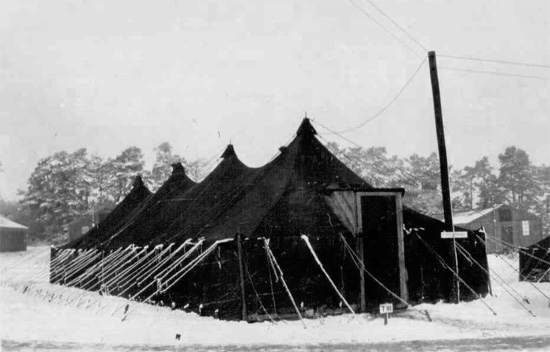
Grimsditch, England, Christmas 25 December 1944, snow! Lonely 250th Station Hospital squad tent in the snow …
On 1 January 1945, the 250th Station Hospital’s census reached over a 1,000 patients, while the unit’s capacity was only 750-beds. Fortunately, extra beds were available in the organization’s tented expansion.
Winter Clothing issued 6 January 1945
4 Vests, Winter, Women’s
4 Panties, Wool, Olive Drab, Winter, Women’s
1 Pair of Anklets, Wool, Olive Drab, Women’s
1 Cap, Service, Wool, Olive Drab, Nurses’
1 Pair of Overshoes, Arctic, 4-Buckle, Women’s
During January and March 1945, more trips took place including visits to London and Bournemouth, followed by a trip to the Isle of Wight. Following V-E Day, a visit to the British Capital was organized, and the number of visitors had to be reduced, as too many were eager to participate. It proved an excellent occasion to see the King and Queen, and the Princess Royal. Brighton was also on the list of places to see.
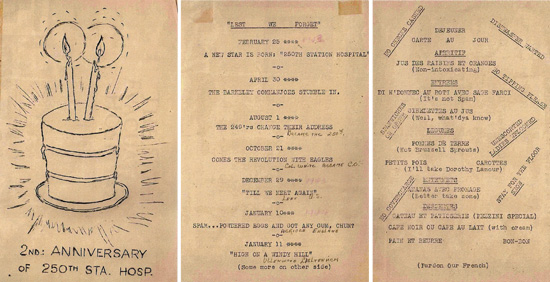
Second Anniversary, 250th Station Hospital, 25 February 1945, celebrated at Grimsditch, England.
Between 17 March – 21 March 1945, Lieutenant Eggert left the Hospital to report for TD for a period not to exceed five (5) days at Bournemouth, Hampshire, as per Paragraph 15, Special Order No. 48, Headquarters, 802d Hospital Center, APO 314, United States Army, dated 14 March 1945.
On 12 May 1945, the ANC Officers went to visit Florence Nightingale’s (1920-1910) grave and honor her memory (Famous Nurse serving in the Crimean War, buried in the graveyard at St. Margaret Church, East Wellow, Hampshire).
Following instructions as per VOCG, United Kingdom Base, dated 20 May 1945, the 250th Station Hospital was instructed to close operation at Grimsditch and depart the United Kingdom, and to travel by sea to Le Havre, France, with furthers orders directing the organization’s ANC personnel to proceed to the “Nurses Staging Area”, Normandy Base Section, by 21 May.
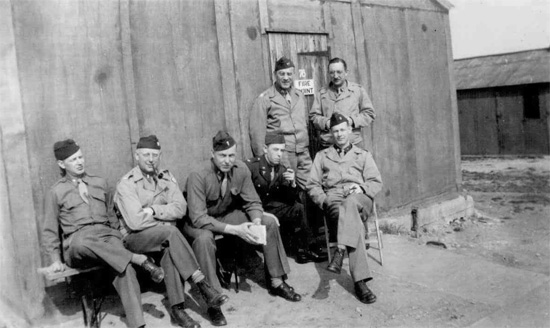
250th Station Hospital Officers during a break, Grimsditch, England, early May 1945. From L to R: Major Josef S. Cope, MC, O-308057; Captain Linus M. Schrems, ChC, O-531579; First Lieutenant Leslie E. Netzen, MAC, O-1535250; Major Albert E. Freed, MC, O-381782; Captain Angelo A. Ciocca, MC, O-1689580: Major William B. Irby, DC, O-370375; Captain Harold C. Rininger, MC, O-399742.
France:
On 20 May 1945, the Hospital left Grimsditch, Hampshire, for Southampton Port where it boarded USAT “Marine Wolf” for the Channel crossing. The 250th reached Le Havre, France, the following 21 May 1945, and following debarkation, the ANC personnel were transferred to the “Army Nurse Corps Staging Area” at Mesnières-en-Bray, France, for quarters and administration. New orders were received 27 May 1945, instructing the Nurses of the 250th (stationed in the Normandy Base Section) to entrain for Verdun, France, as per TWX 5-51, CG, Northern District, Normandy Base Section, APO 562, where they were expected by 29 May 1945. The move went by way of Paris, for many an excellent opportunity to visit the famous French capital city.
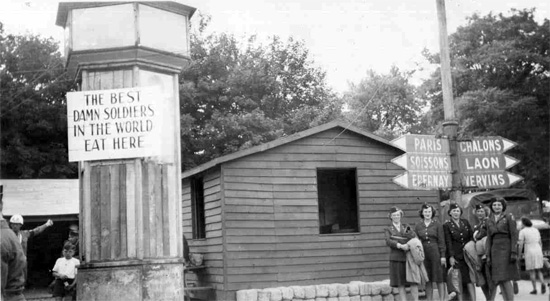
Reims, France, end May 1945. Small group of 250th Station Hospital Nurses sightseeing in France … with plenty to see and visit.
First Lieutenant Margaret M. Eggert, left Verdun, France for Germany on 11 June 1945. She traveled by train to Regensburg, Germany, as per Adjutant General Letter 370.5, Operations, Movement Order 758, Headquarters, Oise Intermediate Section, Communications Zone, ETOUSA, dated 9 June 1945, arriving at Regensburg, 14 June 1945.
Germany:
At the time, the 250th Station Hospital, underwent a change of station, which brought them to Regensburg, Germany, APO 350, on 14 June 1945, where they were to take over two German hospital buildings and function as part of the American Occupation Forces. On 20 June, the 250th relieved the 101st Evacuation Hospital, taking over operation of the entire medical complex, including the “Männerkrankenhaus” and the “Frauenkrankenhaus” (Hospital for Men & Hospital for Women).
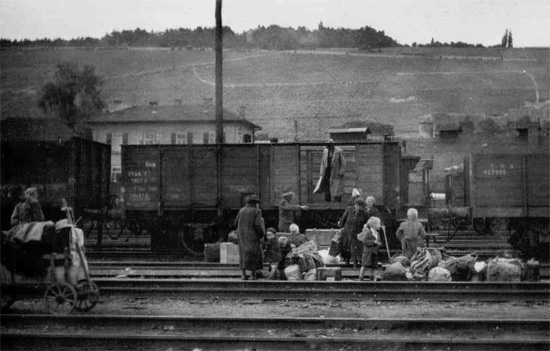
While traveling from Verdun, France to Regensburg, Germany, 11 – 14 June 1945, Nurse M. Eggert took pictures of DPs trying to catch a ride home.
On 15 August 1945, it was reported that Japan was about to surrender. The news kept everyone excited at the prospect of going home …
Home & Discharge:
With an ASR score of only 52 points (registered 2 Sep 45), it was impossible to become eligible for return to the States.
On 24 November 1945, First Lieutenant Margaret M. Eggert, was relieved from duty with the 250th Station Hospital and assigned to the 128th Evacuation Hospital as per Paragraph 1, Special Order No. 218, Headquarters, 250th Station Hospital, APO 403, dated 23 November 1945, signed by Major Katherine L. Knott, ANC, Principal Chief Nurse of the organization. She reported for assignment and duty the same day, as recorded by Captain Alice L. Larsen.
On 27 November 1945 Lieutenant Eggert proceeded from Würzburg, Germany to Camp Mourmelon, France, as per Movement Order, reference Shipment RE-7447, emanating from Headquarters, US Army Forces, European Theater (USFET), dated 21 November 1945, and in compliance with War Department Cable 21720, dated 17 November 1945. She reached destination 29 November 1945.
First Lieutenant M. Eggert, arrived at Camp Phillip Morris, APO 562, France, 4 December 1945, where she was attached, unassigned, to the “Nurses Staging Area”, for shipment to the Zone of Interior, as per Shipment Order # RE-7447-NA, duly signed by Captain Alice L. Larsen, ANC, Principal Chief Nurse. Margaret Eggert traveled on USAT “Thomas H. Barry” (AP-45) sailing from Le Havre Harbor, France, 7 December 1945. Arrival in the continental United States took place on 16 December 1945.
On 20 December 1945, Margaret M. Eggert, was temporarily appointed Captain in the Army of the United States.
Decorations – Captain Margaret M. Eggert
American Campaign Medal
European-African-Middle Eastern Campaign Medal
World War II Victory Medal
Relief from Active Duty – Captain Margaret M. Eggert
Fort Dix, Wrightstown, New Jersey, Separation Center – 28 February 1946

ANC and Medical Officers of the 250th Station Hospital on board transport “Thomas A. Barry” (AP-45), on their journey home, 9 December 1945.
Our heartfelt thanks go to Donald L. Boatright and Mary K. O’Neill, son-in-law and daughter of Captain Margaret M. Eggert, ANC (N-731929) who served with the 250th Station Hospital during World War Two in the European Theater of Operations. Don and Mary were instrumental in helping us discover the many personal recollections and vintage documents kept by Nurse Eggert and provided our staff with a large number of photographs taken by Captain M. Eggert during her service years.
